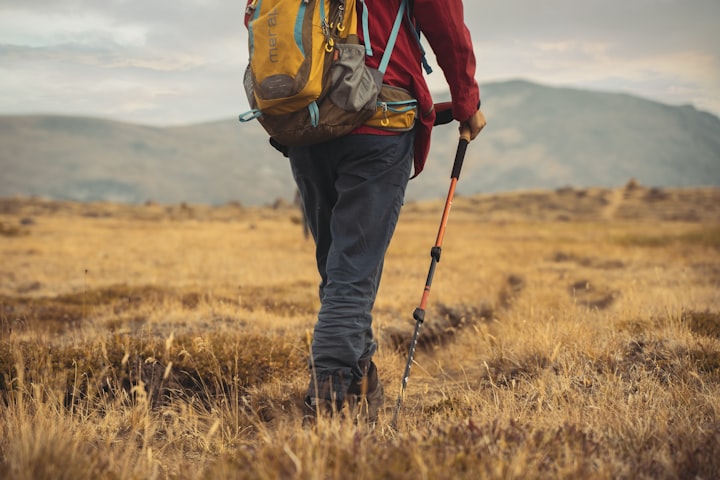How to Choose and Use Trekking Poles and Hiking Staffs
Trekking poles and hiking staffs are standard equipment for many walkers, hikers, trekkers, backpackers and snowshoers.

Many walkers, hikers, trekkers, backpackers, and snowshoers use trekking poles and hiking staffs as basic equipment. The reasons are straightforward: They improve your stability and give you assistance on any terrain.
To get the most out of trekking poles or a hiking staff, follow these steps:
Is it better to live alone or in a couple? To begin, decide whether you want to use a pair of trekking poles or a single hiking staff.
Determine the appropriate length: When the pole tips contact the ground, you want your elbow to bend 90 degrees.
Features to consider: Adjustability, foldability, shock absorption, weight, and locking mechanisms (for adjustable poles) are just a few of the features and alternatives to consider.
Learn how to use poles in the following ways: Knowing a few helpful hints, such as how to utilize poles to get around trail hazards, can help you get started.
Types of Trekking Poles
Hiking Staff:This single pole, also known as a walking staff or travel staff, is most effective when used over relatively level terrain with little or no burden on your back. Hiking staffs may be adjusted, and some even come with a shock-absorbing function. They may also contain a camera attachment incorporated into the handle so that the staff may be used as a monopod. When you hold the poles with their points on the ground at your feet, properly sized poles will bend your elbows at a 90-degree angle. Many trekking poles have changeable lengths, making this just a simple task. Some, on the other hand, are offered in predetermined lengths or size ranges. To discover the proper length poles for you, use these guidelines:
For adjustable-length trekking poles and hiking staffs
If you're taller than about 6 feet, choose a hiking staff or trekking poles that have a maximum length of at least 51 inches.
If you are shorter than 6 feet tall, you’ll be able to shorten most adjustable trekking poles and hiking staffs enough to make them work for you.
Adjusting Pole Length
If you have trekking poles that adjust in length, it’s important to know what height to set them at. Improperly adjusted trekking poles can cause distress to your arms, shoulders, back and neck.
For general hiking- Adjust the length so that your arm bends 90 degrees at the elbow when you hold the pole with the tip on the ground near your foot. This will be sufficient for the most of your trekking.
If you have three-section poles, it's best to set the top adjustment to the center of the range, then adjust the bottom adjustment to the length that puts your arm at the right angle. Then, if you need to alter the length while trekking, you may do it using simply the top adjustment.
For long uphill sections,- To gain additional leverage and more stable pole plantings, shorten each pole by around 5–10cm. The steeper the slope, the shorter your poles should be. Your trekking poles should help you go upward without putting pressure on your shoulders, and your shoulders should never feel like they're being pulled up into your backpack straps in an unnatural, elevated posture. If that's the case, you'll need to shorten your poles even further.
For long downhill sections, try lengthening each pole by about 5–10cm from the length you set it at for general hiking. Doing so will keep your body more upright for better balance.
If you’re on a long traversing section, you can shorten the pole on the uphill side and lengthen the pole on the downhill side as needed to improve comfort and stability.
Trekking Pole Features
Adjustable: Many trekking poles adjust in length to enhance stability on different terrain. They generally adjust from about 24 to 55 inches long. Typically you’ll want to shorten the poles when going uphill and lengthen them when going downhill.
Non-adjustable: Some trekking poles don’t adjust in length. These fixed-length poles tend to be lighter weight than adjustable poles because they operate with fewer parts, making them popular among the ultralight crowd. They are great for activities where you know you only need a certain length.
Foldable: Foldable trekking poles function kind of like tent poles rather than collapsing into themselves like adjustable poles. Foldable poles are typically the most packable and often are very lightweight and quick to deploy. They are especially popular among ultrarunners and fast hikers.
Shock-absorbing poles: These offer internal springs that absorb shock when you walk downhill. With most poles, this feature can be turned off when it's not needed, like when you're walking uphill. Shock absorption is a nice feature for any hiker, but is particularly recommended if you have unstable hips, knees or ankles or have had any previous injuries to those joints.
Standard poles: These do not have a shock-absorbing feature and are lighter and less expensive as a result. While they don't absorb as much impact when going downhill, they do provide a similar level of balance and support as shock-absorbing poles.
Ultralight: Ultralight poles offer the advantage of less swing weight, which makes them easier and quicker to move. Over the course of a long hike, this means less fatigue. Ultralight poles are also easier to pack. The pole shaft's material is a key determinant of the pole’s overall weight. REI classifies ultralight poles as those that weigh less than 1 pound per pair.
Camera mount: Some trekking poles and hiking staffs include a built-in camera mount under the handle, enabling the pole to be used as a monopod.
Trekking Pole Locking Mechanisms
All trekking poles, whether adjustable in length or not, contain locking mechanisms to prevent the poles from sliding in length while in use. The mechanisms on non-adjustable poles lock and unlock, allowing you to stretch them to full length for usage and fold them for storage. Adjustable poles work similarly to fixed poles, but the locking mechanisms allow you to change the length of the two or three interlocking pieces. This adaptability (usually ranging from 24 to 55 inches) allows you to customize the poles to your height and terrain.
Most poles use one of these four types of locking mechanisms
External lever lock: A lever-based, clamplike mechanism that makes pole length quick and easy to adjust, even when wearing gloves.
Push-button lock: Poles with this locking mechanism snap into place and lock with a single pull. Press the push button to release the lock and collapse the poles. Some of these poles do not adjust in length.
Twist lock: Uses an expander and screw setup that is consistently strong and durable.
Combination lock: Some poles use a combination of the other locking mechanisms to achieve a balance of strength, light weight and ease of use. For example, a pole might use an external lever lock on the upper shaft and a twist lock on the lower shaft.
Trekking Pole Shaft Materials
The pole shaft's makeup is a key determinant of the pole's overall weight
Aluminum poles are the most durable and cost-effective option, weighing between 18 and 22 ounces each pair. The weight (and price) of the pole varies depending on the gauge, which ranges from 12 to 16mm. Aluminum may bend under extreme force, but it is unlikely to break.
Composite: The shafts of these poles are composed wholly or partly of carbon fiber. These poles are the lighter and more costly choice, weighing between 12 and 18 ounces each pair. Carbon-fiber poles are effective at decreasing vibration, but they are more prone to fracture or splintering under severe stress than aluminum poles. This is something to bear in mind if you trek in harsh, remote locations.
Trekking Pole Grips
Ergonomic grips with a 15-degree corrective angle are included on some poles and staffs to maintain your wrists in a neutral and comfortable posture. Additionally, some trekking staffs include grips that resemble those on a walking cane. This form provides enough support for mild trekking and easy strolling.
Grip Materials
Grips come in a variety of materials that affect how the poles feel in your hands.
Cork: This resists moisture from sweaty hands, decreases vibration and best conforms to the shape of your hands. If you sweat a lot and will be hiking in hot weather, go with cork grips.
Foam: This absorbs moisture from sweaty hands and is the softest to the touch.
Rubber: This insulates hands from cold, shock and vibration, so it's best for cold-weather activities. However, it's more likely to chafe or blister sweaty hands, so it's less suitable for warm-weather hiking.
Men’s, Women’s, Kids’ and Unisex Trekking Poles
Although some trekking poles are designed expressly for men, women, and children, the vast majority are unisex. Men's, women's, and children's poles differ mostly in length, weight, grip size, and color. Finally, get the poles that best meet your needs and have the colors and features you choose.
Other Trekking Pole Considerations
Wrist straps: It's not uncommon to see hikers inappropriately utilizing their trekking pole wrist straps. Put your hand up through the bottom of the strap and then pull down and hold the grip of the pole to utilize them correctly. This method supports your wrist and heel of your hand while allowing you to maintain your grasp relaxed.You may adjust the length of the strap so that it matches up with where you want your hand to rest on the grip when you pull it down. With proper strap adjustment, you may simply let go of the pole to take a photo, get a food, or adjust your bag, and then quickly reclaim the pole in the proper position.
Baskets: Trekking poles usually include a small, removable trekking basket at the tip end. Larger baskets can be substituted for use in snowy or muddy ground.
Pole tips: Carbide or steel tips are commonly used to provide traction, even on ice. Rubber tip protectors extend the life of the tips and protect your gear when poles are stowed in your pack. They are also good for use in sensitive areas to reduce impact to the ground. Angled rubber walking tips (usually sold separately) are for use on asphalt or other hard surfaces.
Tips for Using Trekking Poles
Alternating Your Poles and Legs
Most hikers rapidly pick up on how to use trekking poles and get into the habit of planting the opposite trekking pole in sync with the opposing foot (right foot, left pole, left foot, right pole, etc.) If you lose your stride, simply keep walking while lifting your poles off the ground for a second to re-center yourself. As soon as you're ready, begin planting the poles again. This will soon become second nature to you, and you won't even have to think about it.
Double Planting
You might wish to plant both poles at once every now and again, then walk two steps, plant both poles again, and so on. This is especially useful on steep climbs or descents where both poles must be on the ground at the same time.
Walking Naturally
When using trekking poles, it’s best to walk naturally and maintain a natural arm swing as if you didn’t have poles in your hands. The poles may be angled slightly behind you so that as you plant them you can push off to aid your forward movement.
Negotiating Obstacles
Trekking poles can be very helpful when you encounter obstacles in the trail.
Stream and river crossings: Trekking poles provide much-needed stability when you have to wade through water. Make sure each time you plant your pole, it’s secure on the bottom before moving forward. If the water is deep, lengthen your poles.
Puddles: You can maneuver around them, using your poles for stability, or you can do a “pole vault” to the other side by planting both poles and hopping over.
Large rocks: For getting up and over large rocks, poles can give you a helpful push. To do this, plant both poles in the ground and as you step up on the rock, push on the poles to get you all the way onto the rock.
Logs: To step over a log, simply plant the poles in the ground and use them for stability. If you’re walking on a log to get across water, you can use the poles to improve your balance by reaching them out to both sides (picture a tightrope walker using a large pole for balance).
Using Poles with Your Tent
Some lightweight tents and tarps require trekking poles for proper pitching. If you own one of these, make sure you have poles that work not only for you but also for your tent or tarp. Most often, adjustable poles will work best for tents and tarps because you can fine-tune the length to make setup easier.
About the Creator
sumedha sumaa
I'm student .I'm 25.






Comments
There are no comments for this story
Be the first to respond and start the conversation.